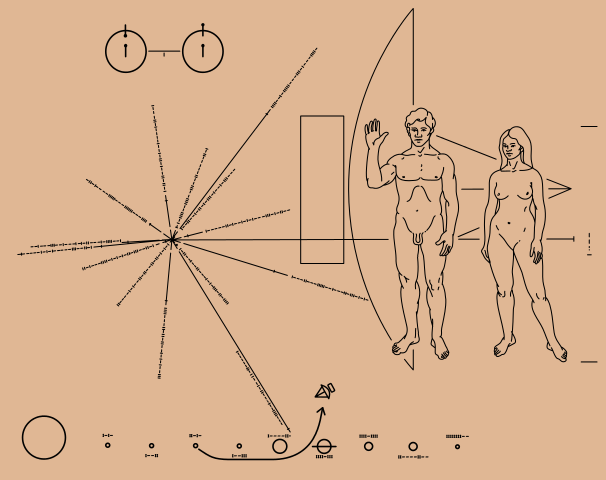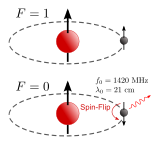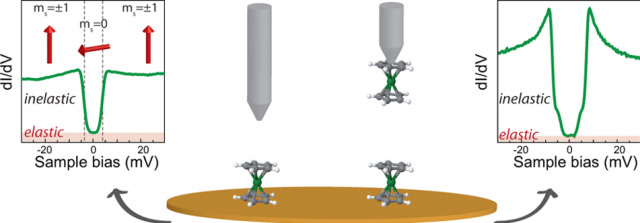A spin-sensitive probe

The Pioneer plaques are a pair of gold–anodized aluminium plaques which were placed on board the 1972 Pioneer 10 and 1973 Pioneer 11 spacecraft, featuring a pictorial message, in case either Pioneer 10 or 11 is intercepted by extraterrestrial life. The plaques show the nude figures of a human male and female along with several symbols that are designed to provide information about the origin of the spacecraft.
But in order to convey useful information a unit of distance and a unit of time were needed. For the first one the plaques portrays the hyperfine transition of neutral hydrogen and uses the wavelength as a standard scale of measurement. And for the second one the hydrogen spin-flip transition was used for a unit of time in a map to Earth included on the Pioneer plaques and also the Voyager 1 and Voyager 2 probes.

But, what is this spin-flip transition? It refers to the atomic transition of an electron between the two hyperfine levels of the hydrogen 1s ground state. But, even though the spin-flip transition has important applications in radioastronomy, in solid state physics they are also interesting.
Just now, a team of researchers that includes Nicolás Lorente, from CFM and DIPC, has been able 1 to functionalize a microscope tip with a nickelocene molecule, as it exhibits an exceptionally efficient spin-flip excitation.
Recent advances in addressing and controlling the spin states of a surface-supported object, atom or molecule, are a big step forward to making quantum computing a reality equipped with an ultimate data-storage capacity. It is the case that information encoding requires that the object must possess stable magnetic states, in particular some kind of magnetic anisotropy, in order to yield distinct spin-dependent states in the absence of a magnetic field, together with long magnetic relaxation times.
Scanning probe techniques have shown that inelastic electron tunneling spectroscopy (IETS) within the junction of a scanning tunneling microscope (STM) is a good starting point to study the stability of these spin states. Actually, STM−IETS allows for an all-electrical characterization of these states by promoting and detecting spin-flip excitations within the object of interest. It can also provide an electrical control over these states, which simplifies the information readout process. As spin excitations need however to be preserved from scattering events with itinerant electrons, single objects are usually placed on nonmetallic surfaces such as thin insulating layers or superconductors.

In this work, the researchers study how the spin of a sandwich molecule, nickelocene, is preserved in different environments, and explain the remarkably efficient spin-flip mechanism it exhibits.

The researchers prove that the molecular spin does not change upon adsorption on a metallic surface. In particular, by attaching a nickelocene to the tip apex of a STM, they show that two spin-flip excitations can be sequentially triggered, which results in a large enhancement of the inelastic signal. This unique situation can be achieved due to the chemical stability, the presence of magnetic anisotropy, the full preservation of the nickelocene spin on the tip apex, or more generally in a metallic environment, and the extremely efficient spin-flip excitation of this molecule.
The portability of the spin-flip excitations, whether of nickelocene or eventually of other molecules, could serve as a spin-sensitive probe (with or without magnetic field) and thereby provide quantitative spin-dependent STM data.
Author: César Tomé López is a science writer and the editor of Mapping Ignorance.
References
- Maider Ormaza, Nicolas Bachellier, Marisa N. Faraggi, Benjamin Verlhac, Paula Abufager, Philippe Ohresser, Loïc Joly, Michelangelo Romeo, Fabrice Scheurer, Marie-Laure Bocquet, Nicolás Lorente, and Laurent Limot (2017) Efficient Spin-Flip Excitation of a Nickelocene Molecule NanoLetters doi: 10.1021/acs.nanolett.6b05204 ↩